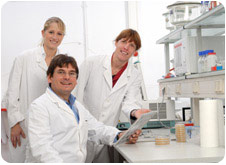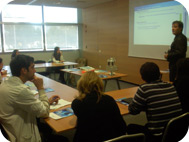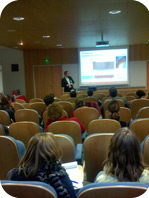LabCluster
Tour "Biologie spatiale"
Mardi 11 octobre 2022 • 9h00 - 12h15 |
|
La participation est gratuite sur inscription Il est possible de s'inscrire à la totalité de la matinée ou seulement à une ou plusieurs conférences.Evénement organisé dans le respect des mesures sanitaires et des gestes barrières. |
|||||
| Cliquez ici pour vous inscrire |
|
||||
Thème de la demi-journée :
| BIOLOGIE
SPATIALE |
||||||
Programme :
Accueil café dès 8H30 De 9H00 à 9H35 VIZGEN : Molecular Atlassing with MERSCOPE Reveals the Spatial Organization of Mouse and Human Tissues Les systèmes biologiques sont constitués de nombreux types de cellules, organisés de manière complexe pour former des tissus et des organes fonctionnels. Les initiatives d'atlas cellulaire avec séquençage d'ARN unicellulaire ont commencé à caractériser les types de cellules sur la base de leurs profils d'expression d'ARN. Cependant, l'organisation du tissu est perdue lorsque les cellules sont dissociées pour le séquençage unicellulaire, ce qui rend difficile l'étude de la façon dont l'hétérogénéité cellulaire contribue à la fonction du tissu. Dans cette présentation, découvrez MERSCOPE, la plateforme de génomique in situ tout-en-un de Vizgen, qui permet le profilage direct de l'organisation spatiale de tissus intacts. De 9H35 à 10H10 RESOLVE : Resolving cellular heterogeneity with highly sensitive spatial transcriptomics Technological advances such as single-cell RNA sequencing accelerated our understanding of cellular diversity in tissues. However, the ability to elucidate this cellular heterogeneity while retaining spatial information is crucial for understanding the complex biological networks in health and disease. At Resolve Biosciences we developed Molecular CartographyTM, a highly multiplexed, single-molecule detection technology to measure transcriptomic activity with full spatial context at subcellular resolution. The unparalleled sensitivity and specificity of Molecular CartographyTM helps scientists detect individual transcripts and rare signals to interpret fundamental biology and rapidly advance the understanding of complex biological questions in oncology, neuroscience and other disciplines. In this presentation, we demonstrate applications in tissues of many different species in which we detect millions of individual transcripts originating from a hundred genes in each sample. This allows us to unravel the complex spatial organization of different cell types and their changes in gene expression in response to disease. 10H45-11H05 : PAUSE CAFÉ De 10H10 à 10H45 AKOYA BIOSCIENCES : Une approche de phénotypage spatial : de la découverte de biomarqueurs à la validation de signatures prédictives, grande échelle • Introduction à la Biologie Spatiale • Les technologies Akoya • Principes et protocoles • Applications • Le programme d’Exploration Spatiale ‘STEP’ comme preuve de concept • Q&R De 11H05 à 11H40 10X GENOMICS: Trailblazing the future of Spatial biology 1. Map the whole transcriptome of entire H&E or immunofluorescence stained fresh frozen and FFPE tissue sections with morphological context. 2. Streamline Visium histology workflows with facilitated transfer of analytes from tissues sectioned on standard glass slides to Visium slides with CytAssist. 3. Get the most recent product updates on Xenium In Situ Analyzer. De 11H40 à 12H15 NANOSTRING : Le GeoMx® Digital Spatial Profiler : un instrument pour automatiser le profilage sur coupes de tissu en haute résolution spatiale
Le GeoMx Digital Spatial Profiler® de
nanoString permet de profiler n’importe quelle région d’une
coupe de tissu avec une haute précision spatiale de l’ordre
du µm2 et en haut débit. |
|||
|
Stands de démonstration et d'information toute la matinée. Venez nous rencontrer. |
|||

| Le nombre de places étant limité, il est fortement conseillé de s'inscrire à l'avance en cliquant ici |
|
|||
| Pour toute question ou demande d'information, cliquez ici | |
![]()



